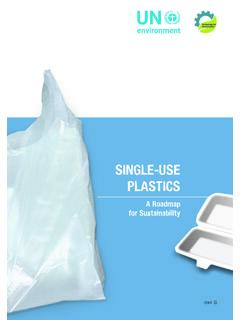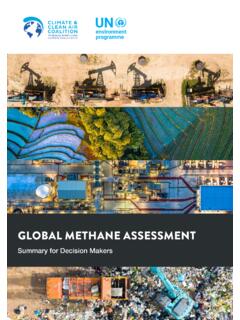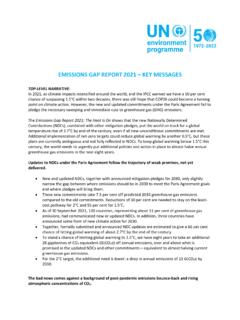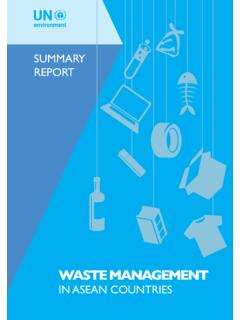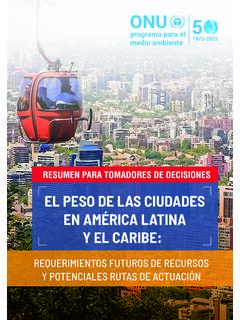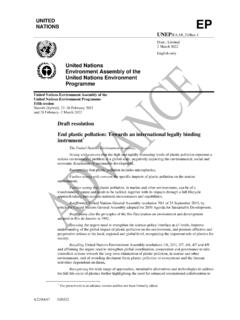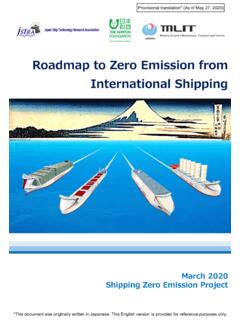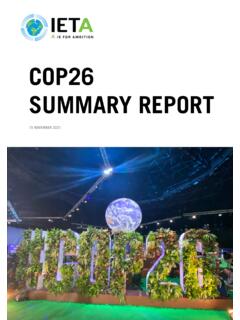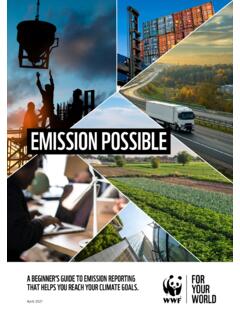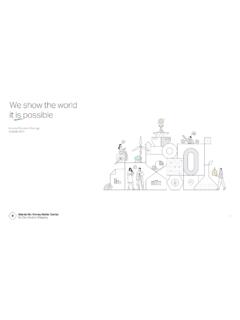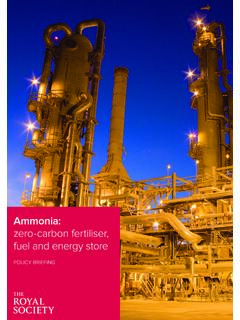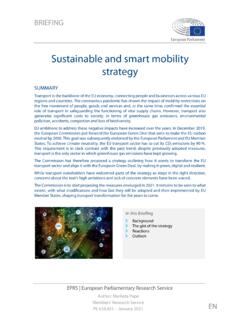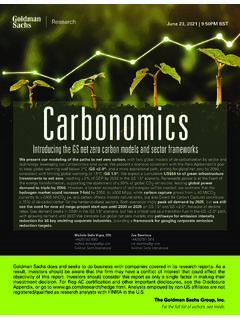Transcription of Executive Summary
1 Executive Summary 2021 United Nations Environment ProgrammeISBN: 978-92-807-3890-2 Job number: DEW/2388/NAThis publication may be reproduced in whole or in part and in any form for educational or non-profit services without special permission from the copyright holder, provided acknowledgement of the source is made. The United Nations Environment Programme would appreciate receiving a copy of any publication that uses this publication as a use of this publication may be made for resale or any other commercial purpose whatsoever without prior permission in writing from the Secretariat of the United Nations. Applications for such permission, with a statement of the purpose and extent of the reproduction, should be addressed to the Director, Communication Division, United Nations Environment Programme, P. O. Box 30552, Nairobi 00100, designations employed and the presentation of the material in this publication do not imply the expression of any opinion whatsoever on the part of the Secretariat of the United Nations concerning the legal status of any country, territory or city or its authorities, or concerning the delimitation of its frontiers or boundaries.
2 Some illustrations or graphics appearing in this publication may have been adapted from content published by third parties to illustrate the authors own interpretations of the key messages emerging from such third-party illustrations or graphics. In such cases, the material in this publication does not imply the expression of any opinion whatsoever on the part of United Nations Environment Programme concerning the source materials used as a basis for such graphics or of a commercial company or product in this document does not imply endorsement by the United Nations Environment Programme or the authors. The use of information from this document for publicity or advertising is not permitted. Trademark names and symbols are used in an editorial fashion with no intention on infringement of trademark or copyright views expressed in this publication are those of the authors and do not necessarily reflect the views of the United Nations Environment Programme.
3 We regret any errors or omissions that may have been unwittingly made. Maps, photos and illustrations as specifiedSuggested citation United Nations Environment Programme (2021). emissions Gap Report 2021: The Heat Is On A World of Climate Promises Not Yet Delivered Executive Summary . NairobiProduction United Nations Environment Programme (UNEP) and UNEP DTU Partnership. by:UNEP promotes environmentally sound pr actices globally and in its own activities. Our distribution policy aims to reduce UNEP's carbon Gap Report 2021 The Heat Is On A world of climate promises not yet delivered Executive SummaryIVEmissions Gap Report 2021: The Heat Is OnExecutive summaryIntroductionThis twelfth edition of the United Nations Environment Programme (UNEP) emissions Gap Report comes during a year of constant reminders that climate change is not in the distant future. Extreme weather events around the world including flooding, droughts, wildfires, hurricanes and heatwaves have continuously hit the news headlines.
4 Thousands of people have been killed or displaced and economic losses are measured in the trillions. Bearing witness to the increasingly clear signs of climate change, the Intergovernmental Panel on Climate Change (IPCC) published the first report in its Sixth Assessment cycle addressing the Physical Science Basis in August 2021. Dubbed a code red for humanity by the United Nations Secretary-General, the IPCC report documents in far greater detail and with higher certainty than previous assessments how climate change and extreme events can be attributed to the build-up of anthropogenic greenhouse gas (GHG) emissions in the atmosphere. There is a fifty-fifty chance that global warming will exceed C in the next two decades, and unless there are immediate, rapid and large-scale reductions in GHG emissions , limiting warming to C or even 2 C by the end of the century will be beyond on the new evidence from the IPCC, the twenty-sixth United Nations Climate Change Conference of the Parties (COP26) is charged with the growing urgency of accelerating global ambition and action on both mitigation and adaptation.
5 This year, the spotlight is on the new and updated nationally determined contributions (NDCs) that countries were requested to submit in advance of COP26. As the September 2021 version of the NDC Synthesis Report published by the United Nations Framework Convention on Climate Change (UNFCCC) illustrates, the new and updated NDCs are insufficient to achieve the temperature goal of the Paris emissions Gap Report confirms the findings of the UNFCCC report. It expands the assessment to consider announced mitigation pledges for 2030 in addition to the new and updated NDCs. The report shows that new or updated NDCs and announced pledges for 2030 have only limited impact on global emissions and the emissions gap in 2030, reducing projected 2030 emissions by only per cent, compared with previous unconditional NDCs, whereas 30 per cent is needed to limit warming to 2 C and 55 per cent is needed for C.
6 If continued throughout this century, they would result in warming of C. The achievement of the net- zero pledges that an increasing number of countries are committing to would improve the situation, limiting warming to about C by the end of the century. However, the 2030 commitments do not yet set G20 members (accounting for close to 80 per cent of GHG emissions ) on a clear path towards net , G20 members as a group do not have policies in place to achieve even the NDCs, much less net zero . Turning to some of the opportunities for bridging the emissions gap and getting on track to net zero , the report assesses the extent to which COVID-19 fiscal recovery measures are used to accelerate a green transition. It examines the scope for reducing emissions from methane, the second-most-important GHG in terms of current anthropogenic climate forcing, to bridge the gap and get on track to net zero . Finally, the report looks into a key negotiation issue for COP26: reaching agreement on how to move forward with article 6 of the Paris Agreement dealing with cooperative approaches and market mechanisms.
7 A large number of countries have included the use of market mechanisms in their NDC implementation plans and are waiting for the modalities to be agreed. At the same time, the use of markets and offsets in meeting net- zero emission goals is often in previous years, the 2021 emissions Gap Report has been guided by an experienced steering committee and prepared by an international team of leading scientists, assessing all available information, including that published in the context of the IPCC reports, as well as in other recent scientific literature. The assessment process has been transparent and participatory. The assessment methodology and preliminary findings were made available to the governments of the countries specifically mentioned in the report to give them an opportunity to comment on the Gap Report 2021: The Heat Is On1. Following an unprecedented drop of per cent in 2020, global carbon dioxide emissions are bouncing back to pre-COVID levels, and concentrations of GHGs in the atmosphere continue to rise.
8 The COVID-19 pandemic led to an unprecedented per cent drop in global fossil carbon dioxide (CO2) emissions in 2020 (figure ). Data are not yet available for all GHG emissions in 2020, but the drop in total global GHG emissions is anticipated to be smaller than the drop in fossil CO2 emissions . A strong rebound in emissions is expected in 2021. Preliminary estimates suggest fossil energy Figure Global greenhouse gas emissions from all sources, 1970 2020CO2 emissions could grow by per cent in 2021 (excluding cement), and global emissions in 2021 are expected to be only slightly lower than the record level of 2019. Despite the large decline in CO2 emissions in 2020, the concentration of CO2 in the atmosphere grew by around parts per million, in line with recent trends. It is unlikely that the reductions in emissions in 2020 will be detectible in the atmospheric growth rate, as the natural variability of around one part per million is far greater than the effect of a per cent reduction in CO2 emissions in a single year.
9 Solving the climate problem requires rapid and sustained reductions in New mitigation pledges for 2030 show some progress, but their aggregate effect on global emissions is insufficient. As at 30 September 2021, 120 countries (121 parties, including the European Union and its 27 member states) representing just over half of global GHG emissions , have communicated new or updated NDCs. This year's assessment considers the new or updated NDCs communicated to the UNFCCC as well as announcements of new mitigation pledges for 2030 by China, Japan and the Republic of Korea not submitted as NDCs by 30 September. Just under half (49 per cent) of the new or updated NDCs submitted (from countries accounting for 32 per cent of global emissions ) result in lower 2030 emissions than the previous NDC. Around 18 per cent of the NDCs (from countries accounting for 13 per cent of global emissions ) will not reduce 2030 emissions relative to the previous NDC.
10 The remaining 33 per cent of NDCs (from countries accounting for 7 per cent of global emissions ) contain insufficient detail to assess their impact on emissions relative to the previous NDC (figure ). Typically, this is due to a lack of information in the previous NDC, rather than the current one; the current NDCs are more 5040302010CH4 LULUCF CO2 Fossil CO2N2OF-gases2020 data only available for fossil and LULUCF CO2 Global greenhouse gas emissions (GtCO2e)VIEmissions Gap Report 2021: The Heat Is OnFigure Effect of new or updated nationally determined contributions on 2030 greenhouse gas emissions relative to previous nationally determined contributions Of the countries that have submitted new or updated NDCs, more (89 per cent) have GHG targets than before (75 per cent). However, these targets are only marginally more comprehensive in terms of sector and gas coverage. The share of new or updated NDCs that are completely unconditional has increased from 24 per cent to 26 per cent, while the share of NDCs that are completely conditional has dropped from 31 per cent to 18 per cent.
